 |
| The Independent Traveler's Newsletter PAGE FIVE |
 |
| The Independent Traveler's Newsletter PAGE FIVE |
| FEATURING LIMOUSIN: the
Haute-Vienne continued
. . . |
|
|
More about Limoges . . . 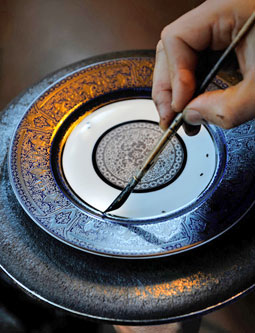 The city of Limoges is perhaps best known for fine porcelain ~ it is synonymous with quality and perfection. Limoges was a well-known center of vitreous enamel production in 12th-century Europe, and in the 1730s some faience earthenware was produced. But it wasn't until the discovery of kaolin clay in Saint-Yrieix-la-Perche near limoges that 'hard-paste' porcelain, similar to that made in China, was possible. They quarried the clay beginning in 1768, and manufacturing was established in 1771 by one Turgot, the newly appointed tax collector for the district which was one of the poorest and most over-taxed in France. Louis XVI's brother, the Comte d'Artois, was put in charge of the manufactory, which was later bought by the King in 1784. Following the French Revolution, private factories were built in Limoges including Bernardaud and Haviland. You can visit the Haviland Porcelain museum to learn all about the design and production process for a company that has survived since its founding in 1842 by David Haviland. Remember that the 2016 Tour de France will pass through Limoges on Wednesday, July 6. On that day, the Tour de France, Stage 5, will begin at Limoges and end at Le Lioran in the Auvergne ~ a distance of 216 kilometers. This is the first of the hilly and mountainous days of the Tour, as the riders cross the Limousin uplands and finish in an altitude of about 5000 feet in the ski resort of Le Lioran in the Massif Central. LE DORAT 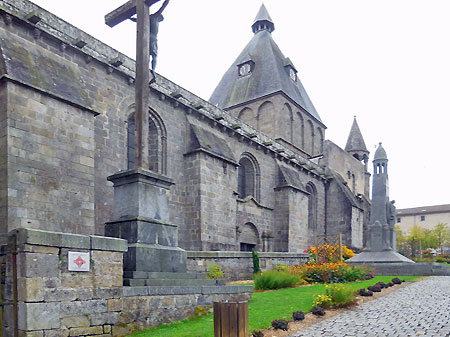 This
commune just north of Bellac, like so many in France, has a
long history. In 866 the church of Le Dorat and its monastery
were sacked by the Normans. In 980 rebuilding was underway, but
it was 1112 that the canons start major construction. It took
until 1170 to add the nave, the façade and the bell tower of the
transept to what became known as the Collegiate Church of
Saint-Pierre. It is one of the most important Romanesque
monuments in the Limousin, and its western façade has a
distinctive Mozarabic influence ~ a reference to Iberian Christians in
Andalusia. It was
intended to accommodate a college of canons, and in the 15th century
both the church and Le Dorat were fortified. We are happy that
our hostess at Château du Fraisse encouraged us to drive to Le
Dorat to see this church, now a Monument
Historique. It is another amazing structure built a
thousand years ago ~ engineered and constructed with decades of labor
through dedication and ingenuity. This
commune just north of Bellac, like so many in France, has a
long history. In 866 the church of Le Dorat and its monastery
were sacked by the Normans. In 980 rebuilding was underway, but
it was 1112 that the canons start major construction. It took
until 1170 to add the nave, the façade and the bell tower of the
transept to what became known as the Collegiate Church of
Saint-Pierre. It is one of the most important Romanesque
monuments in the Limousin, and its western façade has a
distinctive Mozarabic influence ~ a reference to Iberian Christians in
Andalusia. It was
intended to accommodate a college of canons, and in the 15th century
both the church and Le Dorat were fortified. We are happy that
our hostess at Château du Fraisse encouraged us to drive to Le
Dorat to see this church, now a Monument
Historique. It is another amazing structure built a
thousand years ago ~ engineered and constructed with decades of labor
through dedication and ingenuity. < The Collegiate Church of Saint-Pierre, Le Dorat, Haute-Vienne Oradour-sur-Glane 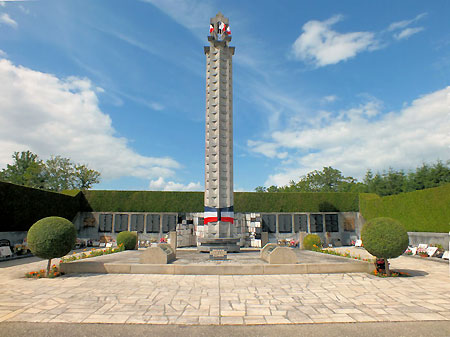 We will never forget our visit to this small village many years ago ~ a tiny commune left exactly as it was after tragedy befell it on June 10, 1944 ~ a commune today with no occupants, no life at all except for those who come to maintain the memorial. When you visit, you are asked not to speak loudly but to whisper as a sign of respect. General de Gaulle declared that it should never be rebuilt, so a new village is nearby for those who wanted to maintain their ties to the martyred one. The town was mistaken for Oradour-sur-Vayres where some members of the Vichy regime paramilitary force claimed that a Waffen SS officer was being held by the Resistance. The Waffen SS came into Oradour-sur-Glane, and in a few hours shot and then burned every inhabitant, leaving the village in ruins. In all, 642 French men, women and children were massacred. Quite amazingly, six men escaped. A television series, The World at War, ended with a narrative by Sir Lawrence Olivier describing event and is the most profound argument against war of any kind. He said, "Down this road, on a summer day in 1944 . . .The soldiers came. Nobody lives here now. They stayed only a few hours. When they had gone, the community which had lived for a thousand years . . .was dead. This is Oradour-sur-Glane, in France. . . They never rebuilt Oradour. Its ruins are a memorial. Its martyrdom stands for thousands upon thousands of other martyrdoms in Poland, in Russia, in Burma, in China, in a World at War . . ." This memorial was built to honor those who died that day. 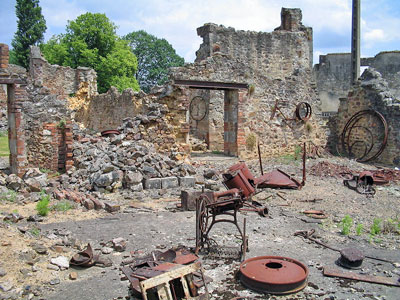 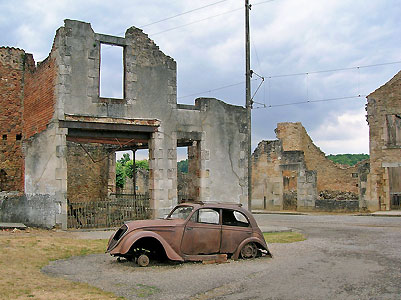 Oradour-sur-Glane
exactly as it was found, including the local doctor's car
Saint-Léonard
de Noblat
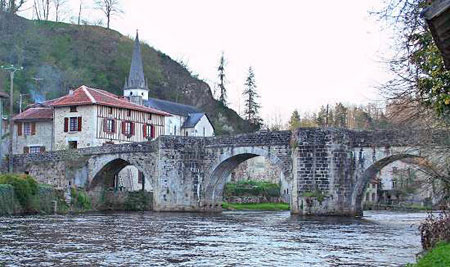 Saint-Léonard de Noblat is a pretty town, one of those that invites your to explore its streets and alleyways. Here you will find timberframe houses from as far back as the 1400s, the museum that was an important paper mill in town from the 15th century to the 1950s, Romanesque architecture and a collegial church dating from the 11th century. Saint-Léonard de Noblat was a very important town along a Medieval pilgrimage route, Route de Saint-Jacques de Compostelle, and today is a recommended detour for travelers. Montrol-Sénard
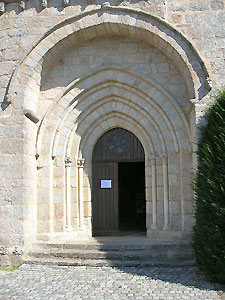 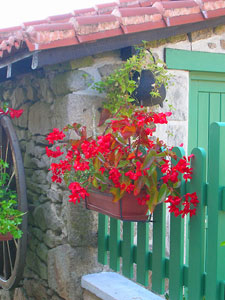 When you travel to France, do you ever find yourself returning to the same places over and over again? That is what we do when we are in the Haute-Vienne. We can't stay away from tiny Mortemart and even tinier Montrol-Sénard up the hill. Stroll through the commune only a few minutes drive from Mortemart. Walk past homes, down little lanes, and enjoy the quite silence. There is little history of this village other than evidence of the Romans when rimmed tiles were found nearby. The cemetery Chapel dates back to the 12th and 13th century where the graveyard is filled with white granite tombs. The Eglise St-Julien de Broude also dates from the 12th and 13th centuries and is worth a visit. It boasts grand Limousin gates, a massive bell and the original 1730 crucifix. and, of The Most
Beautiful Villages of the Haute-Vienne, there is only one: Mortemart
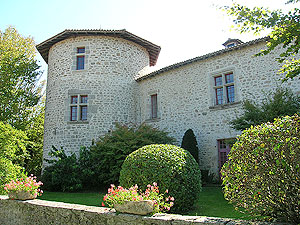 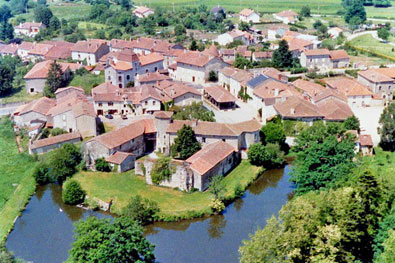 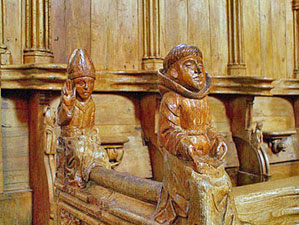 Château
des Ducs de
Mortemart, an aerial view of Mortemart, and some of the many
15th century choir stalls in the church
Mortemart has a little hotel with an excellent restaurant, but it also has a small café in the square ~ LeCafé du Marché ~ with young, new owners and a great menu. As you sit outside for lunch (dinner is not served here) you can admire the Château des Ducs de Mortemart on the banks of a swan-filled pond . . . it's just all too make-believe! 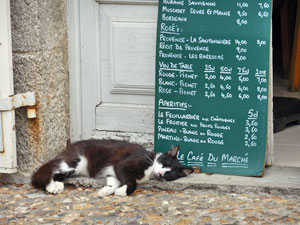 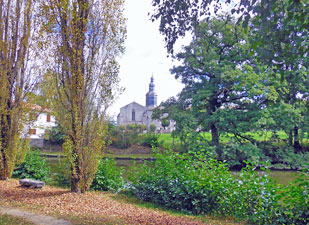 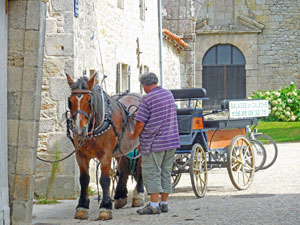 Cat
at the Le Café du Marché, The Augustinian Church of
Mortemart, and A lovely carriage ride
Mortemart can be traced back to a castle built in 995 AD which was the center of the first village here. Little remains of it today aside from the keep, and it was the 14th century that brought three monasteries to Mortemart, two of which still remain although updated in the 17th and 18th centuries. The church of the Augustins boasts the many carved choir stalls as shown above, and has a beautiful altarpiece in the Baroque style. 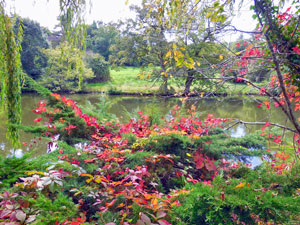 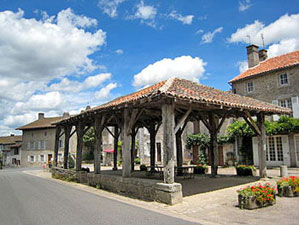 The
pond behind the
château and the covered market in Place Royale (open Sunday
mornings, June to September
NOVEL IDEAS. . . Fiction with a French twist
Any
or all of the above would make great reading at home or on a plane to
France, and, of course, thoughtful gifts for those Francophiles in your
life.
DISCLAIMER: You have received this newsletter because your email address is on our Opt-In mailing list, i.e., you have requested to receive FRANCE On Your Own ©. If you would like to discontinue receipt of this newsletter, please send an email to publisher@franceonyourown.com with "unsubscribe" on the Subject line. Unless indicated otherwise, photos, graphics, artwork and text in the FRANCE On Your Own © newsletter are all the property of Cold Spring Press and FRANCE On Your Own © and cannot be copied, duplicated or used in any manner by anyone without the express written permission of Cold Spring Press. FRANCE On Your Own © is published online by Cold Spring Press, P O Box 26098, San Diego, California 92196-0098. This publication is copyrighted and no portions of the text, artwork, graphics or photographs may be reproduced or distributed in any form or by any means or stored in a database or retrieval system without the written permission of the Publisher. For more information about FRANCE On Your Own ©, visit our web site at http://www.franceonyourown.com. Recommendations made in this newsletter are based upon the personal experiences of the Publishers or contributing writers solely to provide information to subscribers. Cold Spring Press and FRANCE On Your Own © make no endorsements nor are any guarantees or promises of satisfaction given or implied. Any and all information is correct to the best of our knowledge, and the Publishers accept no responsibility for errors and/or omissions. The responsibility lies entirely with the traveler to obtain current information regarding accommodations, availability, schedules, prices, reservations, or any other pertinent details. We do not guarantee the historical accuracy of the contents of articles in this newsletter. Historical accuracy is dependent upon one's sources of information -- and contradictions often exist among those sources. Links to other web sites or email addresses are provided for informational purposes only and do not imply any guarantees of service or endorsement of any organization or their business practices. FRANCE On Your Own © is electronically transmitted via email. To add your email address to our database for this FREE newsletter, send an email to info@franceonyourown.com, and please put Subscribe in the subject line. We do not share email addresses with any other organization. BACK ISSUES of the print version of FRANCE On Your Own © and Free online back issues are available on our web site at http://www.franceonyourown.com/Archives.htm. ©1998-2016
Cold Spring Press All Rights Reserved |
|
 previous
page
previous
page |